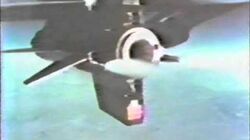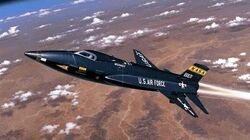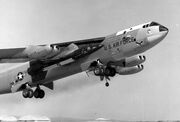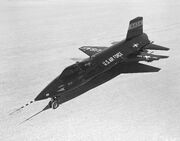
North American X-15 Breaks Mach 4
The North American X-15 rocket-powered aircraft/spaceplane was part of the X-series of experimental aircraft, initiated with the Bell X-1, that were made for the USAF, NASA, and the USN. The X-15 set speed and altitude records in the early 1960s, reaching the edge of outer space and returning with valuable data used in aircraft and spacecraft design. As of 2011, it holds the official world record for the fastest speed ever reached by a manned rocket powered aircraft.

World's Fastest Plane ever North American X 15
The North American X-15 was a rocket-powered aircraft operated by the United States Air Force and the National Aeronautics and Space Administration as part of the X-plane series of experimental aircraft. The X-15 set speed and altitude records in the 1960s, reaching the edge of outer space and returning with valuable data used in aircraft and spacecraft design. As of 2015, the X-15 holds the official world record for the highest speed ever reached by a manned, powered aircraft. Its maximum speed was 4,520 miles per hour (7,274 km/h), or Mach 6.72. During the X-15 program, 13 flights by eight pilots met the Air Force spaceflight criterion by exceeding the altitude of 50 miles (80 km), thus qualifying the pilots for astronaut status. The Air Force pilots qualified for astronaut wings immediately, while the civilian pilots were awarded NASA astronaut wings in 2005, 35 years after the last X-15 flight. The sole Navy pilot in the X-15 program never took the aircraft above the requisite 50 mile altitude.
The Idea[]
The X-planes were and stillare are a series of experimental United States aircraft and rockets, used to test and evaluate new technologies and aerodynamic concepts. They have an X designator, which indicates the research mission within the US system of aircraft designations.
Most of the X-planes have been operated by the National Advisory Committee for Aeronautics (NACA) or, later, the National Aeronautics and Space Administration (NASA), often in conjunction with the United States Air Force. The majority of X-plane testing has occurred at Edwards Air Force Base.
Some of the X-planes have been well publicized, while others, such as the X-16, have been developed in secrecy.
The X-15 was an attempt at hyper-sonic edge-of-space aeronautics.
Development[]
Early flights used two Reaction Motors XLR11 liquid-propellant rocket engines. Later flights were undertaken with a single XLR99 rocket engine generating 57,000 pounds-force (250 kN) of thrust. The XLR11 used ethyl alcohol and liquid oxygen. The XLR99 engine used anhydrous ammonia and liquid oxygen as propellant, and hydrogen peroxide to drive the high-speed turbo-pump that delivered propellants to the engine. It could burn 15,000 pounds (6,804 kg) of propellant in 80 seconds. The XLR99s could be throttled, and were the first such controllable engines that were man-rated.
The Mission[]
During the X-15 program, 13 flights by eight pilots met the Air Force spaceflight criterion by exceeding the altitude of 50 miles (80 km), thus qualifying these pilots as being astronauts.
Of the 199 X-15 missions, two flights (by the same pilot) qualified as true space flights per the international (Fédération Aéronautique Internationale) definition of a spaceflight by exceeding 100 kilometers (62.1 mi) in altitude.
Neil Armstrong flew in X-15 number 1!
The aircraft it's self[]

The Boeing NB-52A (s/n 52-003) permanent test variant, carrying North American Aviation's legendary X-15, and mission markings. Horizontal X-15 silhouettes indicating glide flights, near-vertical ones recording powered ones.

The North American X-15 aircraft, ship #1 (56-6670), sits on the lakebed early in its illustrious career of high speed flight research. X-15-1, serial number 56-6670, is now located at the National Air and Space museum, Washington DC.
It was a strong, aerodynamically shaped, sleek, metalic, rocket like entity like the Bell X-1.
The X-15 fuselage was long and cylindrical, with a pointed, aerodynamic cockpit and nose cone at the front and with rear fairings that flattened its appearance, and thick, dorsal and ventral wedge-fin stabilizers. Parts of the fuselage were heat-resistant nickel alloy (Inconel-X 750). The retractable landing gear comprised a nose-wheel carriage and two rear skids. The skids did not extend beyond the ventral fin, which required the pilot to jettison the lower fin (fitted with a parachute) just before landing.
The cockpit had been modified and was different in several ways to other X-planes. The second setup used the MH-96 flight control system which allowed one joystick in place of three and simplified pilot input. The MH-96 could automatically blend aerodynamic and rocket controls depending on how effective each system was at controlling the aircraft.
Among the many controls, some of which were modified in later flights, were the rocket engine throttle and a control for jettisoning the ventral tail fin. Other features of the cockpit were heated windows to prevent icing, and a forward headrest for periods of high deceleration.
It was carryed aloft by a modifyed USAF bomber and let fligh at an aproprate hight due to it's limited onboard fule supplies Aircraft release took place at an altitude of about 8.5 miles (13.7 km) and a speed of about 500 miles per hour (805 km/h).
Stats[]
Other configurations include the Reaction Motors XLR11 equipped X-15, and the long version.
- Engine type: Rocket engine.
- Nationality: American.
- Made in: USA.
- The World's Fastest Plane (still standing in 2016).
- Role Experimental high-speed rocket-powered research aircraft.
- Manufacturer North American Aviation.
- First flight 8 June 1959.
- Introduction 17 September 1959.
- Retired December 1968.
- Primary users United States Air Force/NASA.
- Number built 3.
- Crew: one.
- Length: 50 ft 9 in (15.45 m).
- Wingspan: 22 ft 4 in (6.8 m).
- Height: 13 ft 6 in (4.12 m).
- Wing area: 200 ft2 (18.6 m2).
- Empty weight: 14,600 lb (6,620 kg).
- Loaded weight: 34,000 lb (15,420 kg).
- Max. takeoff weight: 34,000 lb (15,420 kg).
- Powerplant: 1 × Reaction Motors XLR99-RM-2 liquid propellant rocket engine, 70,400 lbf at 30 km (313 kN).
- Maximum speed: 4,520 mph (7,274 km/h).
- Range: 280 mi (450 km).
- Service ceiling: 67 mi (108 km, 354,330 ft).
- Rate of climb: 60,000 ft/min (18,288 m/min).
- Wing loading: 170 lb/ft2 (829 kg/m2).
- Thrust/weight: 2.07.
Also see[]
- Nickel
- Science
- Bell X-1
- Bell Pogo
- Lockheed X-17
- Bell Jet Belt
- Bell Helli-jeep
- Avro Flying Car
- Bell Rocket Belt
- Bell Helli-vector
- Moor 1969 Jet Pack
- KGB Chita Jet Belt
- RB2000 Rocket Belt
- Manned space travel
- American X-aircraft
- Bell Textron Rocket Belt
- Small Rocket Lift Device (SRLD)